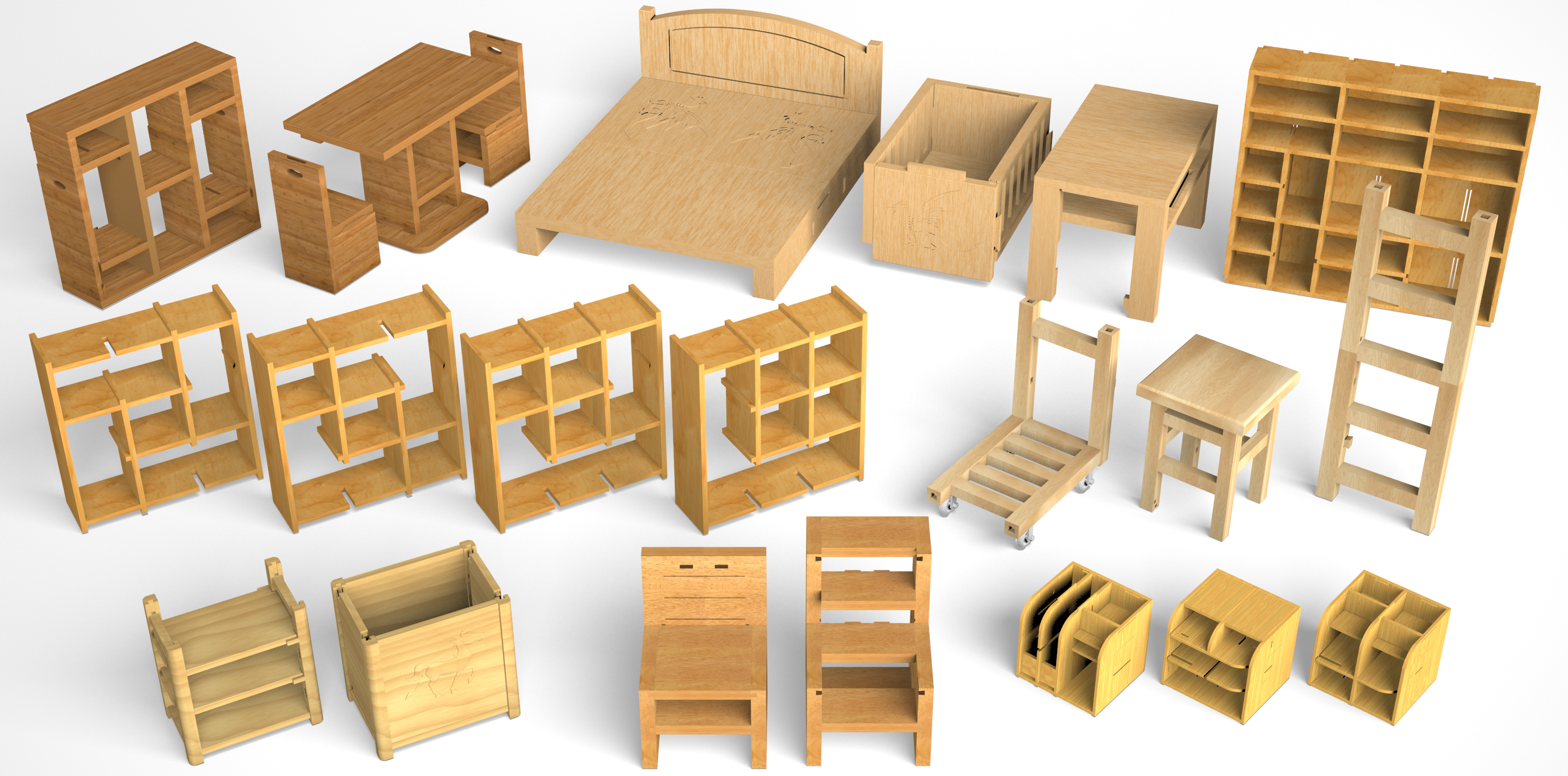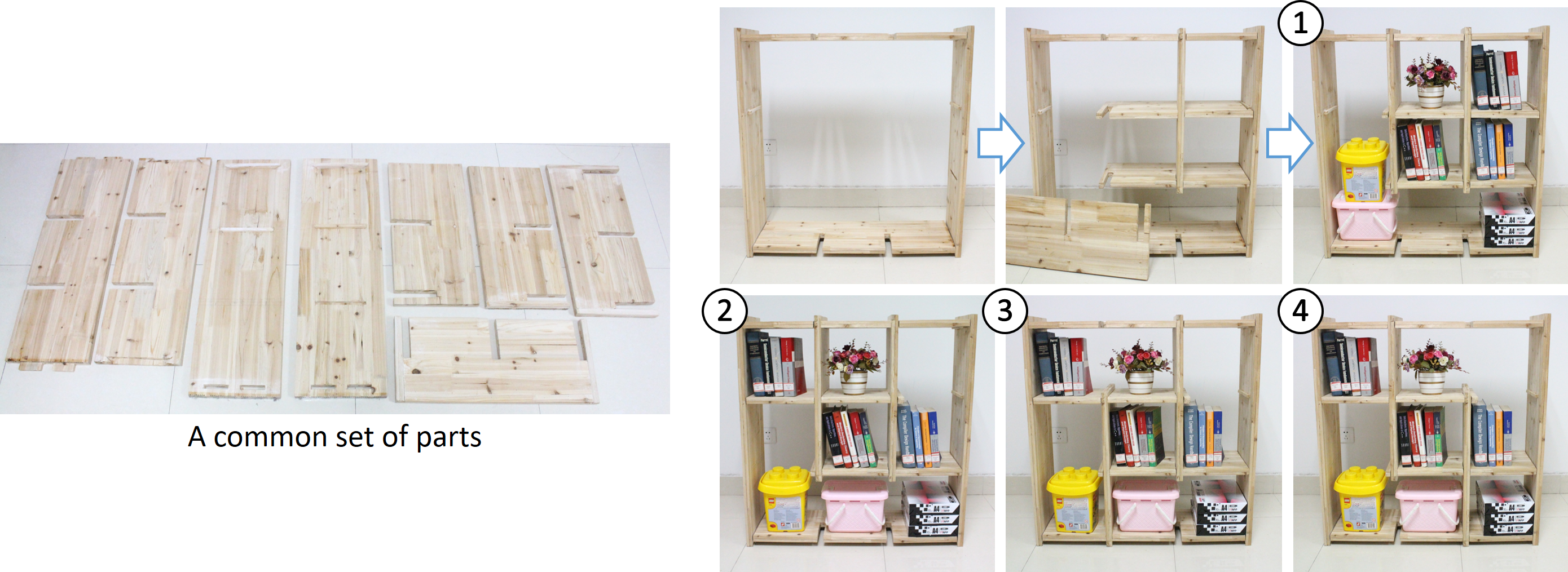Reconfigurable Interlocking Furniture |
Abstract
Reconfigurable assemblies consist of a common set of parts that can be assembled into different forms for use in different situations. Designing these assemblies is a complex problem, since it requires a compatible decomposition of shapes with correspondence across forms, and a planning of well-matched joints to connect parts in each form. This paper presents computational methods as tools to assist the design and construction of reconfigurable assemblies, typically for furniture. There are three key contributions in this work. First, we present the compatible decomposition as a weakly-constrained dissection problem, and derive its solution based on a dynamic bipartite graph to construct parts across multiple forms; particularly, we optimize the parts reuse and preserve the geometric semantics. Second, we develop a joint connection graph to model the solution space of reconfigurable assemblies with part and joint compatibility across different forms. Third, we formulate the backward interlocking and multi-key interlocking models, with which we iteratively plan the joints consistently over multiple forms. We show the applicability of our approach by constructing reconfigurable furniture of various complexities, extend it with recursive connections to generate extensible and hierarchical structures, and fabricate a number of results using 3D printing, 2D laser cutting, and woodworking.Results

Figure 1: Reconfigurable assemblies of different functionality produced by our method: Ladder, Stool, and Hand Truck (left to right).

Figure 2: Overview of our approach. Given two input designs (a), e.g., Step Ladder (top) and Chair (bottom), we first co-decompose them into compatible 3D parts with correspondences highlighted in the same color (b). We then analyze the parts connectivity and iteratively plan compatible joints over corresponded parts with mechanical interlocking (c). Lastly, we create joint geometry on each part (d) to produce a common set of parts (e), fabricate the set, and employ it to build different assemblies (f).

Figure 3: Results. Reconfigurable interlocking furniture generated by our method (from left to right and then top to bottom): Bookshelf, Table, and two Chair; Bed, Cot, and Desk; Armoire (extensible and hierarchical); Bookshelf 1-4; Hand Truck, Stool, and Ladder; Shoe Rack and Laundry Box; Chair and Step Ladder; and Office Box 1-3.

Figure 4: Left: a single-key interlocking box with three unique parts. Right: Armoire composed of tileable boxes and three keys (yellow key symbols) only.

Figure 5: Re-assembling Shoe Rack into Laundry Box. In the two images shown at the beginning and end of the animation sequence, colors on parts reveal the part correspondence. See the accompanying video for the animation.

Figure 6: Bookshelves fabricated by woodworking; the common set of parts can be assembled into four different interlocked forms.

Figure 7: Reconfigurable Office Boxes with a common set of 11 parts.
Acknowledgments
We thank the reviewers for the valuable comments, Ziqi Wang for his help in preparing the laser cutting and 3D printing results, and Thomas Maitz of perludi.com for the photos shown in Fig. 2. This work is supported in part by the Hong Kong RGC General Research Funding Projects (14203416 & 14201717), the National Natural Science Foundation of China (61403357, 61672482, 11626253), the One Hundred Talent Project of the Chinese Academy of Sciences, and the ISF-NSFC joint research program (2217/15).
Bibtex
@article {Song-Fu-2017-ReconfigFurniture,title = {Reconfigurable Interlocking Furniture},
author = {Peng Song$*$ and Chi-Wing Fu$*$ and Yueming Jin and Hongfei Xu and Ligang Liu and Pheng-Ann Heng and Daniel Cohen-Or},
journal = {ACM Transactions on Graphics (SIGGRAPH Asia 2017)},
volume = {36},
number = {6},
articleno = {238},
numpages = {13},
doi = {10.1145/3130800.3130808},
year = {2017},
note = {$*$ joint first author}
}